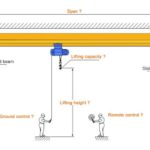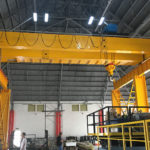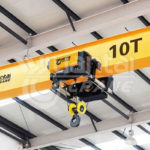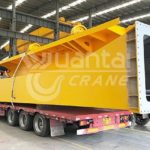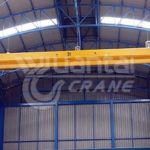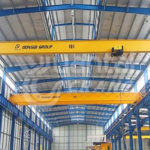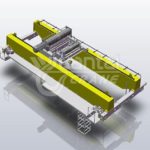Gantry Crane Installation Overview | Gantry Crane Description
A gantry crane is a type of crane that is supported by a horizontal beam and can move along a track or rail. Gantry cranes are used for lifting and moving heavy objects, such as containers, machinery, or building materials. Gantry cranes can vary in size and capacity, depending on the application and the site. Some gantry cranes are fixed in place, while others are mobile and can be relocated as needed. Gantry cranes have several advantages over other types of cranes, such as being able to span large areas, having a high lifting height, and being easy to install and operate. Gantry cranes are used for lifting and moving heavy objects in various industries, such as construction, manufacturing, shipbuilding, and mining. Gantry crane installation requires careful planning, preparation, and execution to ensure safety and efficiency.
Gantry Crane Installation Procedure
- Choose a suitable location for the crane. The area should be flat, level, and free of obstacles. The crane should have enough clearance from the ceiling, walls, and other structures. The crane should also be accessible for maintenance and inspection.
- Prepare the foundation for the crane. Depending on the type and size of the crane, you may need to pour concrete, install anchors, or lay steel plates on the ground. The foundation should be strong enough to support the weight and load of the crane.
- Assemble the crane components. Follow the manufacturer’s instructions and use the appropriate tools and equipment. You may need to use a forklift, a crane, or a hoist to lift and position the components. Make sure to secure all the bolts, nuts, and pins properly.
- Connect the electrical and hydraulic systems. Follow the wiring diagrams and hydraulic schematics provided by the manufacturer. Make sure to use the correct cables, hoses, and fittings. Check for any leaks or loose connections.
- Test the crane operation. Before using the crane for any load lifting, perform a series of tests to ensure that the crane is functioning properly. Check the alignment, level, and balance of the crane. Test the brakes, limit switches, emergency stop, and overload protection. Test the movement and speed of the trolley and hoist. Test the load capacity and stability of the crane.
- Train the operators and workers. Only qualified and authorized personnel should operate the crane. Provide adequate training on how to use, maintain, and troubleshoot the crane. Ensure that all operators and workers follow the safety rules and regulations.
Gantry Crane Design Standards
Some various standards and regulations govern the design, construction, installation, operation, inspection, and maintenance of gantry cranes. One of the most widely recognized and adopted standards is ASME B30.2-2022, which provides safety requirements for overhead and gantry cranes. This standard covers topics such as:
- Markings (warnings, identification, controls, rated load)
- Clearances (from obstruction, between parallel cranes)
- Crane construction (welded construction)
- Construction runways (foundations and anchorages, crane runways)
- Cabs (location, lighting, construction, access to crane)
ASME B30.2-2022 also specifies testing methods for gantry cranes, such as load testing, operational testing, and periodic inspection. The standard aims to prevent accidents and injuries involving gantry cranes by establishing minimum criteria for safe performance.
Other standards that are relevant for gantry crane design include:
- ISO/TC 96/SC 9 – Bridge and gantry cranes
- OSHA 1910.179 – Overhead and gantry cranes
- ANSI Z535 – Safety signs and colours
Gantry Crane Requirement

- Lifting Capacity:
Determine the maximum weight that the crane will need to lift and move. This includes considering both the static and dynamic loads. - Span and Height:
Define the span (distance between the legs) and the lifting height required for your application. This is crucial in determining the crane’s overall size and structure. - Working Class:
Consider the duty cycle or how frequently the crane will be in operation. This information helps determine the crane’s design and the type of components used. - Lifting Speed:
Specify the required lifting speed and precision based on the operational needs of your facility. Different applications may require varying levels of speed and accuracy. - Environmental Conditions:
Consider the environmental conditions in which the crane will operate. This includes factors such as temperature, humidity, and exposure to corrosive substances. These conditions can affect the choice of materials and coatings for the crane. - Control System:
Choose an appropriate control system based on the complexity of the lifting tasks. Options include manual, semi-automatic, and fully automated systems. - Safety Features:
Incorporate safety features such as limit switches, emergency stop buttons, overload protection, and collision avoidance systems to ensure the safety of operators and equipment. - Maintenance:
Design the crane with ease of maintenance in mind. Access points for inspection, lubrication, and repairs should be considered to minimize downtime.
Gantry Crane Inspections
Gantry crane inspections are essential for ensuring the safety and efficiency of crane operations. The purpose of gantry crane inspections is to check the condition and functionality of the crane components, such as the hoist, trolley, gantry, wires, hooks, brakes, and controls. Inspections also help to identify any defects, damages, or wear and tear that may affect the performance or safety of the crane. Inspections should be conducted by qualified and trained personnel, following the manufacturer’s instructions and relevant standards and regulations.
- Pre-operational inspection: This is a daily or before-use inspection that involves a visual and functional check of the crane and its components. The operator should look for any signs of damage, corrosion, leakage, loose or missing parts, or abnormal noises.
- Periodic inspection: This is a more detailed and thorough inspection that is performed at regular intervals, such as monthly, quarterly, or annually. The frequency of periodic inspections depends on the type and usage of the crane, as well as the manufacturer’s recommendations and local regulations. A periodic inspection involves a comprehensive examination of the crane structure and components, using visual, auditory, tactile, and measurement methods.
- Special inspection: This is an inspection that is performed after an unusual event or circumstance that may affect the condition or safety of the crane. For example, a special inspection may be required after a collision, overload, modification, repair, or accident involving the crane.

